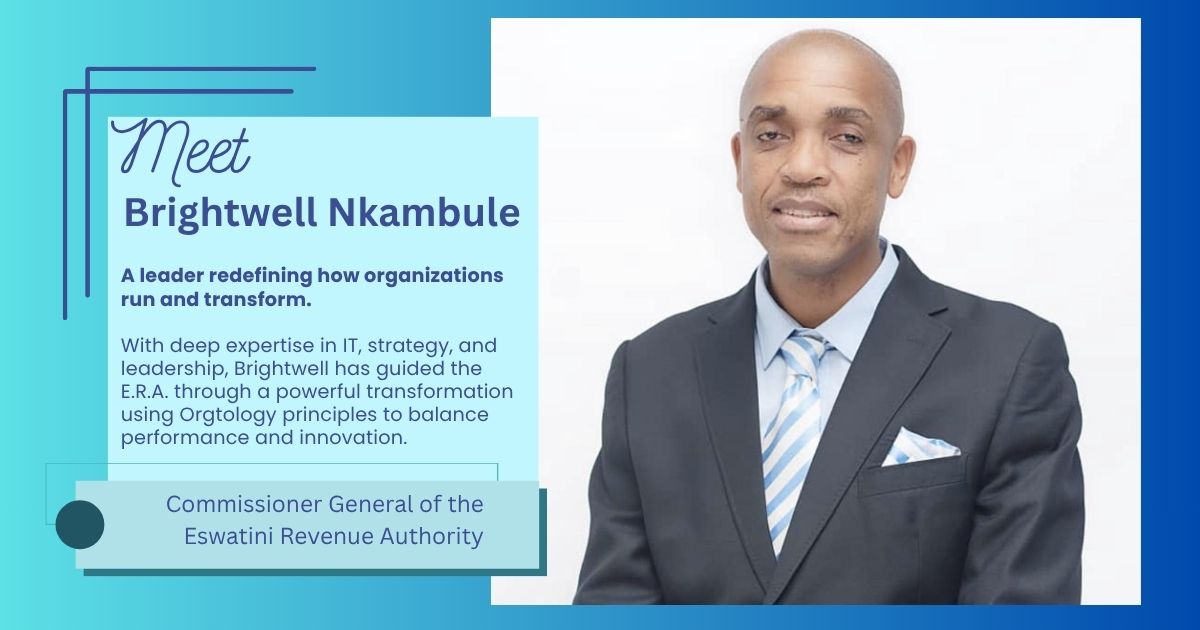Orgtology Business Management: Revolutionizing Organisational Success
written by stoffie grobler
Orgtology Business Management represents a new frontier in organisational science, blending operational precision with strategic relevance. In a recent podcast, Michelle Ashburner sat down with Brightwell Nkambule, Commissioner General of the Eswatini Revenue Authority, to discuss Orgtology, a groundbreaking business management approach that’s transforming how organizations balance operations and innovation for sustained success. Brightwell, a seasoned professional with extensive experience in IT, project management, and business process re-engineering, shared his journey with Orgtology and its profound impact on his organization.
Introducing Brightwell Nkambule
Brightwell, based in the Kingdom of Eswatini, has a rich background in IT and leadership. With a Master’s in Business Leadership from the University of South Africa, he foresaw the rise of project management and business process re-engineering two decades ago. Today, he leads the Eswatini Revenue Authority, overseeing tax collection and customs management, and serves as a part-time consultant for the International Monetary Fund, working across West Africa, South Sudan, and Zimbabwe.
His introduction to Orgtology came through his work with its founder, Derek Hendrikz, in 2016. Brightwell’s experience managing a $400 million telecom network transformation project and leading the Revenue Authority’s transition from a government department to a semi-autonomous entity laid the groundwork for adopting Orgtology’s principles.
The Orgtology Approach
Orgtology, as Brightwell explains, is about creating a balance between running a business and transforming it. When he joined the Revenue Authority in 2011, he introduced project management to drive its transformation, followed by business process development with Deloitte in 2013 and change management in 2014. These efforts laid the foundation for operational efficiency and transformation, but the strategic plan remained unclear until Orgtology provided a streamlined framework.
Orgtology simplifies strategic planning to a single page, focusing on a clear vision and transformation objectives. It distinguishes between day-to-day operations, managed through process constructs, and transformative initiatives, driven by project constructs. This approach eliminates the clutter of traditional, bulky business plans, allowing leaders to focus on long-term goals.
Brightwell highlights Orgtology’s Level Zero model, whit its five key systems: relationships (managing stakeholder connections), core operations (delivering the organization’s primary value), resources (powering activities), transformation (creating sustainable change), and risk (reducing orgnisational risk exposure). These systems work together like the human body, with processes self-regulating while leadership focuses on innovation and sustainability.
Transforming the Eswatini Revenue Authority
Since adopting Orgtology in 2016, the Eswatini Revenue Authority has restructured its processes around its mission, ensuring consistency and efficiency. For example, asset management, previously fragmented across departments, was unified under a single process, streamlining acquisition, utilization, and disposal. This systemic approach allows the organization to run itself, freeing leadership to focus on long-term strategy.
Brightwell emphasizes the concept of the “sigmoid curve,” where processes drive an organization’s upward trajectory, but innovation (a new curve) must begin before decline sets in. Orgtology’s balance of order (processes) and chaos (innovation) ensures organizations remain relevant and sustainable.
Orgtology for Small Businesses
Orgtology isn’t just for large organizations. Brightwell believes it’s equally valuable for small and medium enterprises (SMEs). For SMEs, Orgtology ensures consistent delivery of value propositions through efficient systems, stakeholder relationships, and resource management. It encourages entrepreneurs to dream big while maintaining operational discipline, ensuring predictability and relevance in competitive markets.
The Human Element
Transitioning to Orgtology can initially unsettle employees due to the uncertainty of change. However, Brightwell sees long-term benefits, as it encourages workers to broaden their skills and sell their expertise globally in a “flat” world. By focusing on work rather than departmental loyalty, Orgtology aligns resources with organizational needs, fostering adaptability and productivity.
Why Orgtology Sticks
Brightwell likens adopting Orgtology to embracing a smartphone after using landlines. Once its simplicity and effectiveness are experienced, reverting to traditional methods feels like going backward. Orgtology frees leaders from operational minutiae, allowing them to focus on future threats and opportunities, such as those presented by the Fourth Industrial Revolution.
Becoming an Orgtologist
Brightwell’s journey to mastering Orgtology involved weekly sessions with Derek Hendrikz, divided into four modules. These sessions combined practical discussions, idea-sharing, and working papers that applied Orgtology to real-world scenarios. The program’s rigorous, hands-on approach challenges participants to rethink business management.
Who Should Embrace Orgtology?
Brightwell recommends Orgtology for leaders in production, service industries, and entrepreneurship. Executive teams and entrepreneurs, in particular, can benefit from its focus on aligning work with organizational purpose, driving efficiency, and fostering innovation.
Looking Ahead
As Brightwell continues to apply Orgtology, he sees it as part of a broader “new world order” accelerated by global shifts like COVID-19. By embracing Orgtology, businesses can navigate change, balance order and chaos, and achieve sustainable success. For those ready to transform their organizations, Orgtology offers a clear, actionable path forward.
